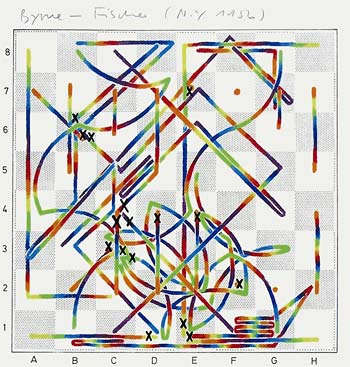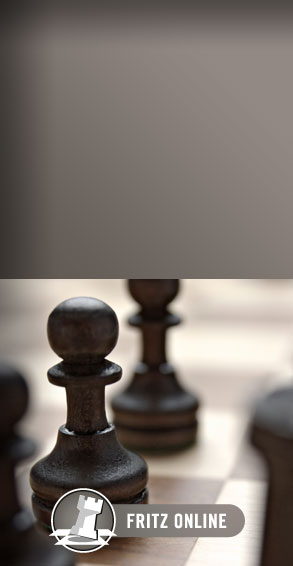Chess is more complete than life
By Prof. Christian Hesse
Ultimately chess is just chess – not the best thing in the world and
not the worst thing in the world, but there is nothing quite like it. –
W.C. Fields

If you are a parent of small children – like myself – the following type of
dialogue may sound familiar to you:
Your child: Why can I have only one glass of apple juice?
You: Because we will eat dinner soon, I don’t
want you to spoil your appetite!
Your child: Why does apple juice spoil my appetite?
You: Because it's filling and it has a lot of
sugar!
Your child: Why can't I have sugar?
You: Because it will make you more thirsty and
it's not good for your teeth!
Your child: Why is sugar not good for my teeth?
You: Eating sugar attracts bacteria and they
make holes in your teeth!
Your child: Why do bacteria make holes in my teeth?
At this point some things may run out, such as your patience, and possibly
you ask yourself if this will ever end. A good question. Indeed, logically it
may not end: Start with any question. And after every answer “Because….” simply
ask “Why?”. In this fashion, a trilemma is created, a dilemma with three rather
than merely two unsatisfactory alternatives. The philosophers call this particular
one the Muenchhausen trilemma. These are the three alternatives:
- The sequence Question, Answer, Question, … continues ad infinitum. This
is referred to as infinite regress.
- In the sequence of questions and answers at one point further down the road
an earlier answer may appear again. This is called circular reasoning. If,
e.g., someone claims that all opponents of an attitude of tolerance are stupid
and then defends this view by saying: “If they weren't stupid, they wouldn’t
oppose it”, that person is presenting a circular argument, apart from stating
something massively self-defeating.
- One can declare a statement as being self-evident, speak ex cathedra or
appeal to a higher authority (e.g. God).
In mathematics, for example, the third option is chosen. One starts to build
a theory from a set of so called axioms, i.e. truths that one places at the
beginning, which one cannot prove but takes as self-evident. Then from these
initial truths further truths are derived: New knowledge follows from old knowledge
through the application of logical arguments (rules of inference such as modus
ponens). Famous in mathematics are the axioms of Euclid with which he began
his epic studies of geometry, such as his Axiom 1: “For each pair of distinct
points there is a unique line that passes through these points.”
All three of the mentioned alternatives are intellectually unsatisfactory.
And in view of this trilemma, life is somewhat incomplete.We can never logically
assert something.
What about chess?
Chess is a self-contained universe of 64 squares with 32 pieces and certain
well-defined laws of motion. Is it possible to assert or prove something in
chess? For example the simple statement: “In a certain position, White is better.”
One could try to reason like this: If White plays a certain move, then Black
is worse. Why is Black worse? Because after any Black move, White is always
better. Why is White always better? Because after any Black move, White has
a move after which Black ist worse…. Looks like an infinite regress here also,
just as the one we encountered before.
But a closer look shows that this is not the case. There is no Muenchhausen
trilemma in chess. In principle, there are definite truths in chess, and here
is how to see why.
Change the perspective for a moment and start at the very end of the game:
consider a database with all positions in which Black is mated. It contains
only a finite number of positions. Then consider a second database connected
to the first one. This second database contains all positions in which White
can give mate in one move. Then a third database connected to the second in
which Black to move cannot defend against White mating him in 1, and so on.
Always one half move further away from mate. One can – in principle –
continue this process sequentially up to positions with all 32 pieces and White
to move. Then the set W of all these 32-piece positions is connected through
the shortest path in this sequence of databases to a mate position. Starting
from one of these 32-piece positions, the corresponding path shows the moves
for perfect play by both sides. If it is Black's move, there is no other defence
that can delay his being mated longer. If it is White's move there is no alternative
that gives him a faster mate. The set W hence contains all positions in which
White can force a win.
Something analogous can be done from Black's perspective, starting with a database
of all positions, in which White is mated. Continuing similarly as above, one
gets a set B of 32-piece positions in which, with White to move, Black has a
forced win. All other 32-piece positions, i.e. all except those in the sets
W and B, make up a set D and lead to a draw with best play on both sides.
As a result, one can envision a database containing all legal positions and
with a unique verdict being attached to each one of them: +1, ±0, –1 denoting
White wins, draw, Black wins. So, in principle, we have designed an algorithm
to construct perfect play in chess. Of course, in practice this is utopic for
the full set of 32-piece positions. Not anymore though for six-piece endgames
and even for some seven-piece endgames. But more importantly while objective
truth is impossible in life, it is, in general, possible in chess. In this sense,
chess is more complete than life.
Still even in chess there are curiosities attached to the theme of this note.
Consider for example the following position from a discussion related to quantum
logic in chess:
Vasilenko and Frolkin, 1995

Mate in two moves
(a) Diagram
(b) After the first two half moves
(c) Before the last two half moves
If you have a position with the stipulation “White mates in n moves” and you
play two half moves, namely the best white move and the best black response,
then you should obtain a position on which you can put the stipulation “White
mates in n–1 moves”. But this is not the case in the above problem.
Similarly, if from the starting position you go back two half moves, taking
back the last black move (if there is a unique one) and after that the last
white move (again if there is a unique one) then you should arrive at a position
on which you can pin the stipulation “White mates in n+1 moves.” This, also,
is not the case in the above problem.
In fact in all three positions (a), (b), (c), no matter whether you rewind
by two half moves or move forward by two half moves from the above diagram,
you still arrive at positions with the stipulation “White mates in 2”. A case
of some very unusual arithmetic on the chess board: 2–1=2 and 2+1=2. And a fascinating
example where two positions which differ by a legal move have a logically different
future.
Can you find the solution in each of the three cases?
Hint: Remember the convention used in chess problems that an en passant capture
is only permissible if it can be proven that the last move prior to the diagram
position was the double-step of the pawn to be captured.
The solution to this problem will be provided in the next installment.
 About
the author
About
the author
Christian Hesse holds a Ph.D. from Harvard University and was on the faculty
of the University of California at Berkeley until 1991. Since then he is Professor
of Mathematics at the University of Stuttgart (Germany). Subsequently he has
been a visiting researcher and invited lecturer at universities around the world,
ranging from the Australian National University, Canberra, to the University
of Concepcion, Chile. Recently he authored “Expeditionen
in die Schachwelt” (Expeditions into the world of chess, ISBN 3-935748-14-0),
a collection of about 100 essays that the Viennese newspaper Der Standard
called “one of the most intellectually scintillating and recommendable books
on chess ever written.”
Christian Hesse is married, has a six-year-old daughter and a two-year-old
son. He lives in Mannheim and likes Voltaire's reply to the complaint: ”Life
is hard” – “Compared to what?”.




















 About
the author
About
the author




